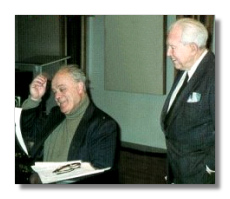
The Internet's Premier Classical Music Source
Related Links
Recommended Links
Site News
Charles Rosen on Elliott Carter

Happy Birthday, Elliott Carter
The composer Elliott Carter will be eighty on December 11, but these dates might mislead one about his place in history. Pierre Boulez, twenty years younger than Carter, has remarked, "He does not belong in the generation into which he was born; he really belongs to my generation." It is not just that Carter looks like a man two decades younger than his age, or even that he has produced some of his most important works in the past few years. It is rather that he came into prominence along with men a generation younger than he is, that he is most easily considered critically along with the group of composers, above all European, whose work begins in the early 1950s, like Boulez, Stockhausen, and Berio.
Born in New York in 1908, Carter spent his childhood in comfortable circumstances. He finished his education at Harvard, majoring in literature, and then went to Paris like so many other American composers to study with Nadia Boulanger. Perhaps equally important for his future development was a trip to Vienna at the age of seventeen, when he acquired the scores of the new Viennese school, including the earliest serial works of Schoenberg. Even more significant was meeting Charles Ives a year before, whom he admired and continued to see often, and who encouraged his ambitions at composition.
Carter never succumbed totally to the influence of Ives, and he was never even briefly to try serial composition. Eventually he also cast aside the influence of Stravinsky and the neoclassical school transmitted in Paris by Boulanger. With it, he cast aside the exploitation of folk material that one finds in Aaron Copland and other American followers of the Paris school. Folk material had only appeared halfheartedly in Carter's early works, which are interesting above all for their characteristic and complex rhythmic energy.
The years from 1935 to 1950 were difficult ones for Carter. Wide recognition came only in 1951, when he was forty-three, with the first String Quartet. Before this, however, his individuality had been revealed in the Piano Sonata of 1946 and the Sonata for Cello and Piano of 1948. In these pieces Carter dramatized the instruments: in the cello sonata each instrument is given different harmonies, rhythms, tempi, and textures inspired by its sonorities. Carter constructed what he was later to call "an auditory scenario for the players to act out with their instruments."
The major works that followed each took about three years to compose: Variations for Orchestra (1955); Second String Quartet (1959); Double Concerto for piano, harpsichord, and two small orchestras (1961); Piano Concerto (1965); Concerto for Orchestra (1969); Third String Quartet (1971). All these developed the concept that different instrumental groups and different sonorities should produce different senses of time: in Carter's work, these contrasting temporal perspectives are not simply opposed but are combined in ways that rarely allow one of them to become dominant. It has been said that just as Schoenberg destroyed the sense of a unique harmonic center, so Carter has done away with the idea of a single rhythmic framework: in his music, time is no longer measured with a single yardstick or by a uniform beat. However, he has not destroyed the sense of uniform objective time by a continuously fluctuating rubato, as in Boulez, or by recourse to the play of chance, as Cage and Stockhausen preferred to do, but by organizing conflicting subjective perceptions of time into a dramatic form in which they each simultaneously find free and individual play. Carter's works embody the multiform experience of time in modern life.
These works brought him his fame: Stravinsky remarked of the Double Concerto that at last one could speak of an American masterpiece. At first his fame was greater in Europe than in America; in fact, Carter accomplished a fundamental shift in the relation of American and European music. Carter was the first American composer outside the field of popular music to achieve his reputation not as a minor follower of a European school or as a provincial voice exploiting a purely native material. His style is at once independent and international.
The poetic imagery of these works is most striking: the soaring trumpet solo inspired by Hart Crane's description of the sea gull over Brooklyn Bridge that opens the Symphony of Three Orchestras (1976); the passionate viola cadenza of the Second Quartet; the chorale of the wind instruments of the Double Concerto accompanied by the accelerating staccato and pizzicato phrases of piano, harpsichord, strings, and four percussion players that trace patterns in space on the stage; the immense cluster of pianissimo strings that invades the end of the Piano Concerto like a cloud.
Since 1971 the works have appeared with greater frequency. The vitality of the production is remarkable. The song cycles on poems by Elizabeth Bishop, John Ashbery, and Robert Lowell bring to the voice the lyricism already found in so many of the instrumental works. The most recent works, above all Night Fantasies for piano (1980) and the Oboe Concerto (1988), have all the power and complexity of the middle period with an even greater concentration. It is sometimes said that the recent works are more accessible than those of the Sixties: it is perhaps only that the public has gradually learned to listen to Carter's music as it has slowly become part of the vernacular.
[This article originally appeared in the New York Review of Books, 1988]
© 1988, 1998, Charles Rosen













